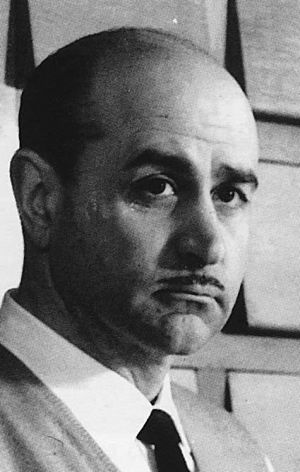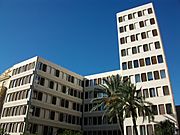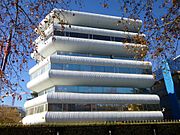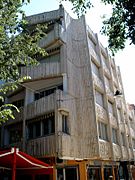Miguel Fisac facts for kids
Quick facts for kids
Miguel Fisac
|
|
|---|---|

Fotografía de Miguel Fisac, hacia 1950
|
|
| Born | 29 September 1913 Daimiel |
| Died | 12 May 2006 Madrid |
| Occupation | Architect |
| Works | Moroder Building, headquarters of Secretaría General de Pesca del Ministerio de Agricultura, Alimentación y Medio Ambiente, iglesia de Santa Ana y Nuestra Señora de la Esperanza |
| Website | http://fundacionfisac.com/la-fundacion/origen-y-estructura-2/ |
Miguel Fisac (1913–2006) was a famous Spanish architect. An architect is someone who designs buildings. He was also an urban planner, which means he helped design how cities and towns are laid out. Besides that, he was a painter!
About Miguel Fisac
Miguel Fisac Serna was born on September 29, 1913, in Daimiel, a town in Spain. His father was Joaquín Fisac, and his mother was Amparo Serna. Miguel had six brothers and sisters. One of his sisters, Dolores 'Lola' Fisac, was among the first women to join Opus Dei, a Catholic organization.
When Miguel was 17, he moved to Madrid to study architecture. He was a member of Opus Dei from 1935 to 1955. During the Spanish Civil War, he went to France. After the war ended, he returned to Spain and finished his architecture studies in 1942. In 1957, he married Ana María Badell. Miguel Fisac passed away on May 12, 2006, in Madrid, at the age of 92.
Famous Buildings by Fisac
Miguel Fisac designed many important buildings. Here are some of his well-known works:
- Centro de Estudios Hidrográficos, located in Madrid (built in 1963).
- Laboratorios Jorba, also in Madrid (built in 1967). This building was famously known as La Pagoda because of its unique shape. Sadly, it was torn down in 1999.
Gallery
Here are some pictures of buildings designed by Miguel Fisac.
See also
 In Spanish: Miguel Fisac para niños
In Spanish: Miguel Fisac para niños






